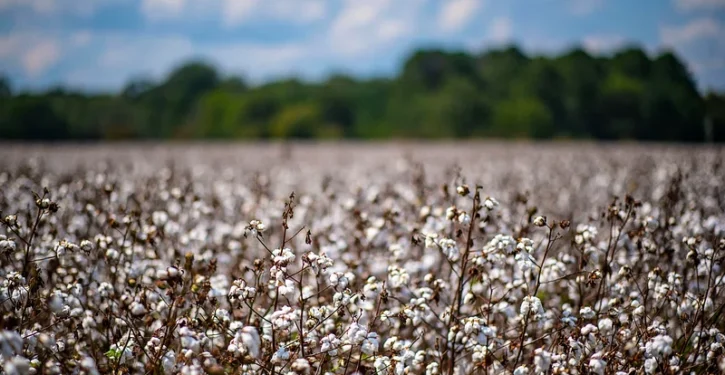
Picking cotton is painstaking if done by hand. An alternative is to use a mechanical harvester, but those can weigh more 30 tons and harm the health of the soil by compressing it.
So researchers are developing cotton-picking robots that have sticky hands to pick cotton, sort of like a lizard’s tongue. A researcher explains:
Picking cotton manually, as is still done in some major producing countries, is a meticulous task. Workers have to bend to reach the [cotton] bolls and can hurt their hands on hard, dry parts of the plants. To harvest the seed cotton, they have to grab and twist it to separate it from the boll without leaving fiber behind.
Starting in the 1930s, cotton farmers in the U.S. shifted from manual labor to large, heavy harvesters. Now the industry is entering a new stage that promises to be more efficient and precise.
I am an engineer and have nearly 20 years of research experience working on agricultural machinery. My current focus is on agricultural robotics and automation. During my Ph.D. program at Mississippi State University, I worked…to develop a robotic cotton harvester that picks cotton with less damage to the product and the soil where it grows.
Cotton farmers have economic, environmental and agricultural reasons to want a better option for harvesting. Traditional mechanical harvesters can be up to 14 feet long and weigh more than 30 tons. They remove cotton effectively without damaging the plants but also can cause problems.
One issue is prolonged fiber exposure. Cotton bolls don’t all mature at the same time; the first open bolls in a field may wait for up to 50 days to be picked, until more bolls around them ripen.
Another challenge is that harvesting machines compact the soil as they roll over it. This makes it harder for water and fertilizer to penetrate down to plant roots. And the machines cost roughly US$1 million apiece but are used for only two to three months each year.
Robotics is a potential solution that farmers are already using for other crops, such as fruits and vegetables. Harvesting robots use cameras and sensors to detect when crops are ready to pick and can remove them without damaging the plant.
For cotton, robotics offers more targeted picking of bolls that are ready to harvest. It produces better-quality cotton fiber by picking seed cotton as soon as the bolls open, without leaving it exposed to the weather. The robot targets the seed cotton and avoids touching other parts of the plant.
With robotic picking, cotton farmers don’t need to use defoliants to remove leaves from the plants prior to harvesting, which is a common practice now. And small, nimble robots don’t compress the soil as they move over it, so they help maintain soil health.
Our work focuses on designing an end-effector for robotic cotton harvesting. An end-effector is a robotic hand that enables the robot to interact with other objects. Ours is a three-fingered version designed for delicate and efficient cotton picking. It draws inspiration from nature, mimicking the hunting prowess of a lizard.
Each finger is a 3D-printed structure that contains a moving belt with pins attached to it. The pins help the hand grasp and pull in the seed cotton. Like a lizard snatching prey with its sticky tongue, our end-effector’s three fingers approach the seed cotton delicately. On contact, the cotton fibers stick to the machine’s fingers, much as an insect sticks to a lizard’s tongue.
Next, the hand retracts quickly, like the lizard’s tongue. The end-effector keeps working to “swallow” the seed cotton, transferring it out of the plant. As the harvester picks and transfers seed cotton out of the plant, the end-effector touches parts of the cotton boll with remaining seed cotton multiple times to pick as much as possible….
The robot uses a deep-learning algorithm that we have trained to recognize open bolls on cotton plants. It uses a stereovision camera to calculate their 3D spatial coordinates, which it transfers to the robotic arm. A control algorithm monitors each cotton boll to ensure that the robot picks as much seed cotton as possible.
Researchers hope their robots will be used in low-income cotton-producing countries such as China, India, Pakistan and Uzbekistan. Cotton is typically picked by hand in these major cotton-producing nations, often by women and children and sometimes in conditions of virtual slavery, as with China’s Uyghur population, hundreds of thousands of whom are used as forced labor by China’s communist government. They think that one way to make this technology available for small farmers in those nations would be to manufacture smaller, semi-autonomous robots that would require fewer sensors.
Robots with artificial intelligence are spreading on Japanese farms. In the U.S., farming robots now use artificial intelligence to kill 100,000 weeds per hour. Drones with artificial intelligence will make farming easier.
Robots are also being use for food preparation, such as the salad-making robot used by the Sweetgreen restaurant chain. Robot waiters are increasingly being used in South Korean restaurants, which are facing a labor shortage.
Chipotle is investing in a “digital makeline” where robots prepare salads and bowls. It already uses a machine named Chippy to make tortilla chips and a contraption called the Autocado to mash avocados into guacamole. Sweetgreen has a robotic chop-and-prep system that “can produce up to 100 salads in 15 minutes, with improved accuracy,” according to Restaurant Business. Chipotle’s founder, Steve Ells, is opening a chain of robot-run vegetarian fast-casual restaurants in New York City called Kernel, according to Eater.
Doctors recently used a surgical robot to carry out incredibly complicated spinal surgery. Doctors also recently did the first robotic liver transplant in America.
Scientists have developed tiny robots made of human cells to repair damaged cells. Nanorobots are also being used to fight cancer. “In a major advancement in nanomedicine, Arizona State University scientists…have successfully programmed nanorobots to shrink tumors by cutting off their blood supply,” reported Next Big Future.
Artificial intelligence is now developing highly-effective antibodies to fight disease. Doctors overseas are using artificial intelligence to detect cases of breast cancer more effectively.



